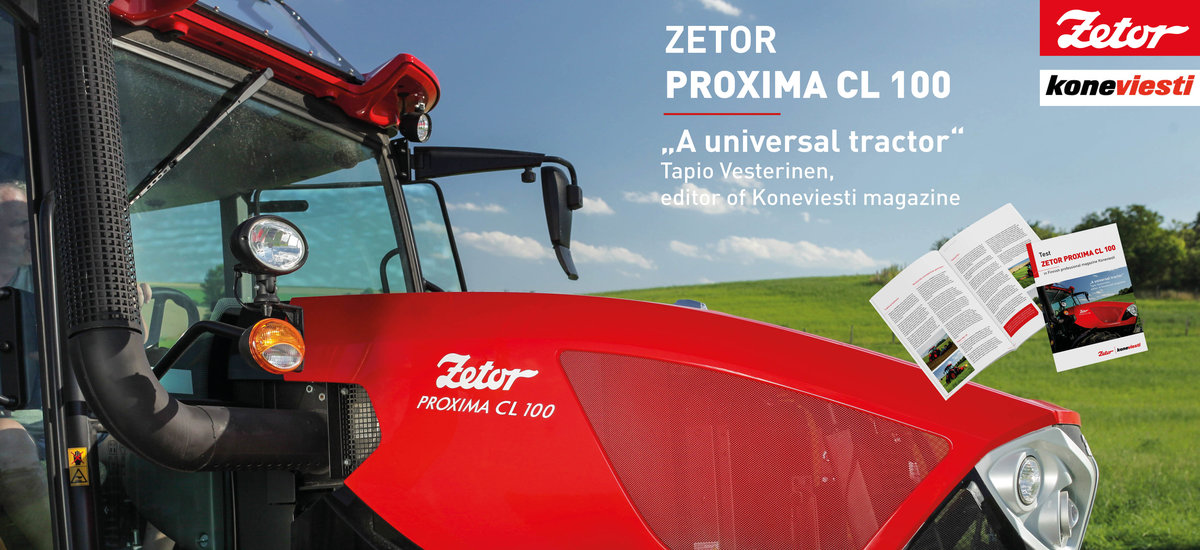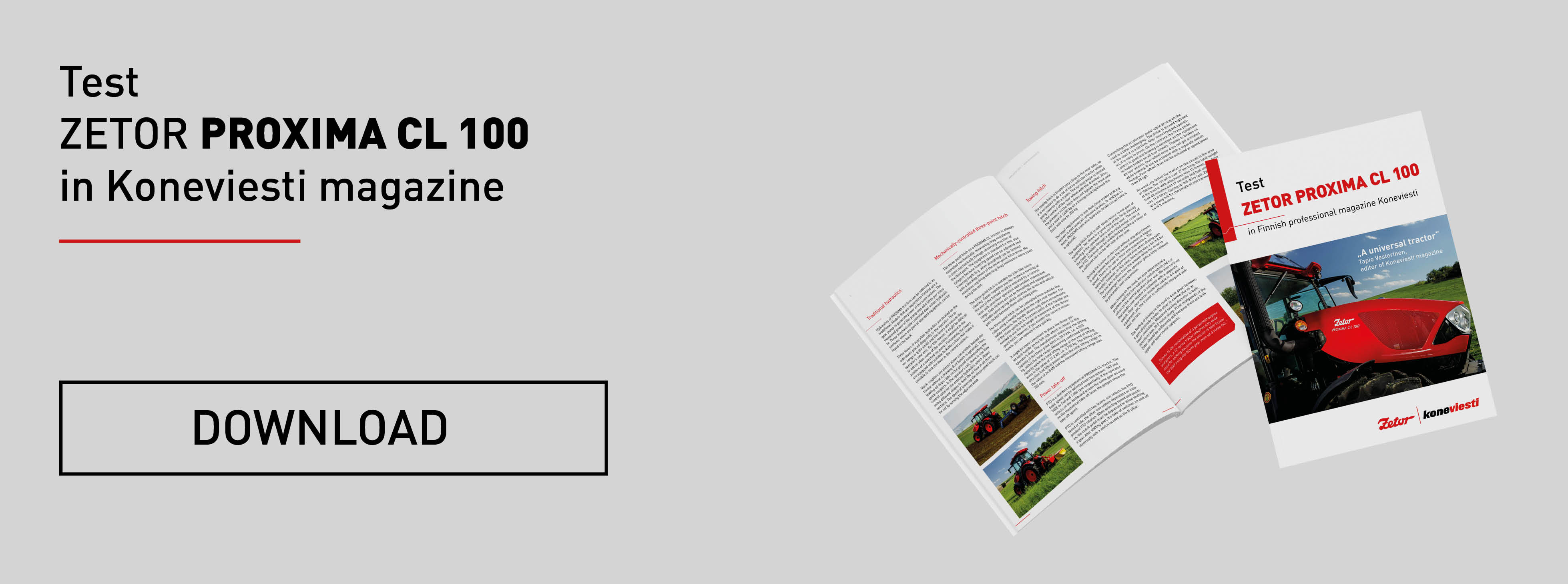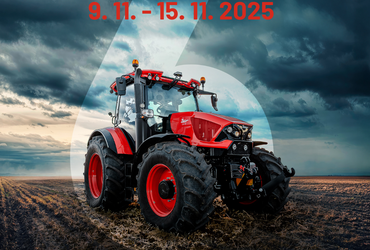- About Tractors
- 15.12.2021
ZETOR PROXIMA CL 100 in Finnish professional magazine Koneviesti
Přihlášení

Our tractor, ZETOR PROXIMA CL 100, was chosen for the 19th issue test in the Finnish professional magazine Koneviesti in 2020. Have a look at the exklusive professional review of the tractor, which is one of the most popular ZETOR tractors with the customers. Universal, reliable, and robust. Those are PROXIMA tractors.
In 2000, ZETOR PROXIMA model range was subject to a number of innovations. It is offered in three different versions and the tested model, Proxima CL, is the basic version equipped with mechanical gearbox. The innovated tractor was tested with a trailer and feeder trailer.
Globally, PROXIMA is one of the most popular model ranges of the ZETOR brand. It was first introduced in 2004. In 2020, it was given a new design of the exterior based on the Italian study ZETOR by Pininfarina. The new design is not only a visual benefit; it also improves view of the front loader due to new shape of the roof and bonnet.
The PROXIMA model range comprises the models PROXIMA CL (76–107 HP), PROXIMA GP (76–107 HP) and PROXIMA HS (76–117 HP). PROXIMA CL is the basic model equipped with a mechanical 12/12 gearbox or with creeper 20/4 gears. In addition, PROXIMA GP offers 2° torque multiplier and PROXIMA HS three-stage torque multiplier and electrohydraulic gearbox reverser.
In-house engine
The 4.2 litre four-pot, which is produced in-house, is special in having a mechanical serial injection pump. The engine meets IIIB emission standard so it does not require urea; diesel particulate filter suffices to clean the exhaust fumes and nitrogen oxides are reduced through exhaust fumes recirculation.
Such solution was possible as the ZETOR type is included in class T2. As there is no possibility of a transition period, engines of the PROXIMA range will probably meet Stage V in the future.
Based on measuring instruments data, the diesel particulate filter regenerated quite quickly during easy load of the tractor even if it was equipped with a tipping trailer for the major part of the journey.
Technical data say that the engine power is 70.4 kW (96 HP) at rated revolutions 2,200 rpm. We reached 68.4 kW at 1,600 rpm. Maximum torque at 1,520 rpm reached the value of 410 Nm. At the rate of revolutions during maximum performance, fuel consumption was 236 g/kW; at the rate of revolutions during maximum torque, it was 234 g/kW.
Performance curve is of a funny shape because the numbers of revolutions during maximum performance and during maximum torque are quite close to each other. It did not appear to be a problem during the ride as the pull of the engine was really strong at travelling speed over 1,500 rpm. Performance is good at higher revolutions; however, the best performance is reached in the range of 1,500-2,000 rpm.
The sound of the engine is even, sharp and loud; it can be easily heard both outside the tractor and inside the cabin which is quiet otherwise. The range of sounds is extended by one of a compressor, which is part of standard equipment. Cooler has a fixed fan; there is no viscous clutch.
Mechanical gearbox
PROXIMA gearbox is also produced in-house in ZETOR. CL models are always equipped solely with a fully mechanical gearbox. The main gearbox has six gears; range gearbox has two stages. It is also equipped with mechanical reverser with a controller on the left side of the wheel.
The shifting lever is quite long, which makes it surprisingly easy and comfortable to operate. It is located far enough from the wheel but at the same time it can be easily reached by the operator. Reverse gears are approximately by 9 % faster than forward gears.
For a beginner, using the shifting lever can be challenging. To ensure quick shifting, revolutions must be at the correct level. However, it was a matter of getting used to it and after some time, it was not hard to find the required gear. Still, the function of synchronous clutch takes some time so when in heavy terrain, we found it easier to use double-clutching. User manual says that durability of a synchronous clutch is much prolonged when double-clutching is used for shifting gears.
The shift pattern is reversed, i.e. odd gears are closer to the operator. The six shifting gears ensure that the tractor has no problem to drag a trailer and it is able to set off using the second gear even when loaded. In a hilly terrain, the range between the fourth and fifth gears is long so, when climbing, it is difficult to reach sufficient speed in the fourth gear to be able to shift to the fifth gear without losing power.
In the sixth gear, the engine reaches maximum speed of 40 kph at 2,400 rpm. In the lowest gear of the slow range, at 2,000 rpm which are required for the performance, the travelling speed is about 1.8 kph which is an acceptable but a bit faster speed for emptying a feeding trailer. Creeper gearbox is an optional equipment.
The range shifting lever is located quite low and the operator must reach out to get a hold of it. Yet, the shifting itself is smooth when the main gear is idle. Rear clearance of the PROXIMA tractor has been advanced by using a portal axle. Front and rear clearance is both 43 cm.
The highest power in drag, 57 kW (78 HP), was measured at the speed of 7.8 kph. The loss of power as opposed to the power measured on PTO reached 17 %, which is a normal value for mechanical gearboxes. The connection of 4WD is electric.
Traditional hydraulics
Hydraulics of PROXIMA tractors can be referred to as traditional. Models that are exported to Finland use a gear pump to generate power of the open system. The measured power of the pump was 60.6 litres per minute. Three mechanically controlled dual action hydraulic sections, which are part of standard equipment, can be found in the back.
Three levers of operation hydraulics are located on the side tower placed diagonally to the operator. The lever range is quite small and the levers are outside the operator’s view axis. For this reason, it might be difficult to notice when some of the sections remained in the position of a switched-on pump. Fortunately, the levers are equipped with suitable lockable collars that make it possible to lock the lever in the central position.
Quick-couplers are placed above one another behind the tractor without a draining duct (which is optional). Thus, leaking oil drips right on the ground contaminating the quick-couplers. In the operator’s cab, there is one flow control valve for the external hydraulics which allows using different stages to limit the oil flow in all three sections. The speed of lowering the three-point hitch can be set by turning the adjacent knob.
Mechanically-controlled three-point hitch
The three-point hitch on a PROXIMA CL tractor is always controlled mechanically; measuring drag resistance is done mechanically through observing reaction of the third point. The equipment is standard for this size category because lowering speed can be adjusted and lowering depth (e.g. when ploughing) can be limited with a blocking device of the three-point hitch lever. No machines requiring detecting drag resistance were used during the test.
The three-point hitch is suitable for jobs like snow clearing. Easier repetitive use (for instance turning at the end of the furrow) could be ensured by a control lever with smoother operation and smaller movement range. Side limiters are set by threading and equipment includes spiral spring which centres the arms and which gets locked between them with fixing pins.
The three-point hitch can be controlled from outside the cabin using a handle located on the right rear fender. For safety reasons, the handle allows only short movements of the three-point hitch. Fourteen pulls of the handle are needed to use the full length of movement of the three-point hitch. However, if you master the correct movements, you can operate it very quickly.
It might be more convenient to place the three-point hitch handle on the left side which is closer to the operator’s door. The manufacturer states that the lifting capacity of the three-point hitch is 39.7 kN, i.e. 4,050 kg, within the total range. Measuring confirmed lifting capacity within the total lifting range at the end of lifting arms in the value of 37.2 kN, i.e. 3,790 kg. The lifting construction had lifting power within the total lifting range in the value of 26.8 kN and the measured lifting range was 700 mm.
Power take-off
PTO is a standard equipment of PROXIMA CL tractor. The basic speed can be selected from two options: 540 and 540E or 540 and 1,000 rpm respectively. If the operator selects on the dashboard screen the same gear as used on the mechanical take-off lever, the gauges show the take-off speed.
PTO is controlled with two levers: one selects the PTO speed or idle, the other one selects dependent or independent PTO rotation. When selecting speed and position, the clutch pedal must be depressed to allow shifting a gear. After shifting gear, the take-of switches on and off electrically with a switch located on the B pillar.
Towing hitch
The towing hitch is located very close to the rear axle, so it is necessary to do a lot of turns with the tractor while going reverse with a trailer. The turning angle is limited by the contact of the rear wheel with the drawbar. Also, the pressure on the hitch does not lighten the front axle and a load of 1,400 kg on a towing hook lightened the front axle only by 200 kg.
Thanks to the combination of a persistent engine and gears, a 10-tonne trailer requires only little need for shifting because the tractor is able to tow the load using the fourth gear even up a steep hill. The legal requirement to use dual-hose trailer braking system is met using air-pressure brakes. In addition to them, PROXIMA uses also hydraulic brake circuit (which is optional).
The towing hitch itself is stiff. Hook mirror is not part of equipment. Yet, there is a good view of the hook during lowering if the operator leans out of the seat. The end of the hook is visible through a perforated metal cover of the PTO. The hook can be unblocked by pushing a lever of a sufficient size on the left side of the seat.
Driving the tractor on the road without any attachment is quite uneven because the tractor bounces at higher speed. There is no cab or front axle suspension. The same behaviour was experienced also when driving with a trailer; however, in this case, bouncing was a bit milder. The one who suffers from the uneven drive the most is the passenger because the operator gets a little relieved by pneumatic seat suspension.
When driving on the road, we also experienced a problem with the turn indicator switch which did not return to the central position after use. We also noticed that windscreen washer is activated with a separate switch. Rear-view mirror inside the cabin is not part of equipment; yet, the tractor is sufficiently equipped with other mirrors.
The feeling of driving on the road is quiet good; however, it gets physically harder to steer in narrow places at lower revolutions. Measured turning diameter in both directions was 10.5 metre sharp. Front mudguards of the Zetor should be sufficiently stiff because there are both upper and lower metal supports.
Controlling the accelerator pedal while driving on the road is a little challenging. The pedal is located high and at the start it is a bit firm. After more frequent operation, it is easy to press. On the contrary, the brake pedal control is good and braking is excellent as the equipment includes brakes on all four wheels. Thanks to brakes on all four wheels, four-wheel drive does not get activated while braking; it can be activated with a separate switch though. Four-wheel drive can be activated at speed lower than 20 kph.
As usual, we tested the tractor on the circuit in the area of Vakola. The circuit is over 27 km long, the total weight of the tractor with attachment was 15 tonnes, the drive took 48 minutes and 19 seconds and fuel consumption was 11.8 litres. During up-hill drive test, Zetor towed load up a steep hill for the length of one kilometre and duration of 3 minutes.
Spacious cabin
The new cabin of Proxima tractor is spacious and well-arranged when looking from the outside. The cabin is quite noisy mainly due to the engine. At full speed, the measured noise inside the cabin was 80.5 dB, or respectively 81 dB when driving on the field. We carried out the measurements in both situations at full engine revolutions. The numbers say that at speed lower than 10 kph, the noise level is a bit higher than at the speed of 40 kph.
Fresh air without dust is brought into the cabin through a roof window as air-conditioning can be ordered as option. The tested tractor was not equipped with air-conditioning. The steering wheel can be sufficiently adjusted; yet, its control is not really practical for repetitive use which would make it easier to exit the cabin. The passenger seat is spacious; however, the upholstery is so soft that a passenger of an average weight almost sits on the iron board which forms the frame of the seat. The brake pedals link is practical and can be disengaged with a shoe tip so that a single brake can be used while turning.
Standard working lamps comprise two front lamps located in the mask and two side lamps. At the tail, there are two side lamps and upper working lamps. All lamps are halogen; the light cone of upper working lamps is quite narrow so they must be pointed right at the spot that needs to be illuminated.
Engine starts in freezing conditions
In Vakola, we also tested the heating of the Zetor for heating the cabin and defrosting an artificially made layer of ice on the windscreen. The tractor started without bigger troubles in temperatures as low as minus 15 degree Celsius. For the course of the sixty-minute test, the ice in the vision angle of the windscreen did not melt. A partial reason for that was definitely a fixed cooler fan, which cooled the engine for the entire time. For comparison, the Koneviesti magazine 14/2015 stated that during a Scandinavian winter test, the temperature in the cabin of ZETOR PROXIMA POWER 120 reached 24 degrees at the end of the same test. In this situation, the average temperature in the cabin reached a bit over 11.5 degrees at the end of the test. Ice started to melt in the upper corners of the windscreen where the nozzles are located. In the middle of the upper edge of the windscreen there is a defrosting jet because of the roof window.
Persistent and practical
PROXIMA CL 100 is a well-arranged universal tractor with mechanical control of functions. The feelings which prevail after operating the tractor are engine persistence, spacious cabin and easy control.
Text: Tapio Vesterinen, Koneviesti 12/2020



